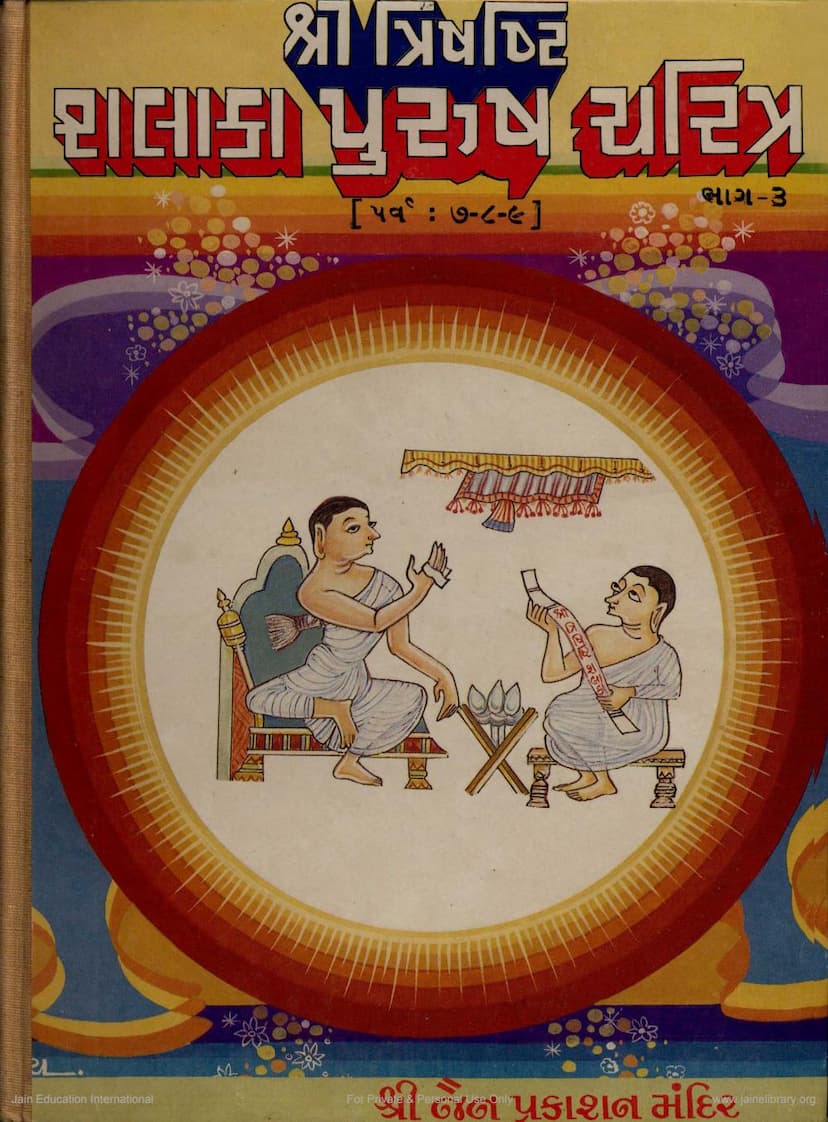Trishasti Shalaka Purusa Caritra Part 3
Added to library: September 2, 2025

Summary
This comprehensive summary is based on the provided text, covering Parts 7, 8, and 9 of the Trishasti Shalaka Purusha Charitra, focusing on the characters and events described in the Gujarati text.
Book: Trishasti Shalaka Purusha Charitra, Part 3 (covering Parva 7, 8, and 9) Author: Hemchandracharya Publisher: Jain Prakashak Mandal, Ahmedabad Catalog Link: https://jainqq.org/explore/001012/1
This volume of the Trishasti Shalaka Purusha Charitra is a significant work detailing the lives of the 63 illustrious figures in Jain tradition. Part 3 specifically covers:
-
Parva 7: This section is particularly rich in narratives, featuring:
- The detailed lives of the 8th Baladeva, Vasudeva, and Prativasudeva – Rama, Lakshmana, and Ravana.
- The story of Shri Naminathji.
- The chronicles of the 10th (Harishana) and 11th (Jaya) Chakravartis.
- It also delves into the origins of the Rakshasa and Vaanara dynasties, tracing their lineage through various Tirthankaras' eras, including Ajitnath Prabhu and Shreyans Prabhu. Key figures from these narratives include Kirtidhaval, Shrikant, Sugriva, and Hanuman. The text highlights the complexities and conflicts between the Rakshasa and Vaanara lineages, with strategic alliances and rivalries playing out.
- The detailed narrative of Lord Rama's life, from his birth to his eventual renunciation and rebirths, is a significant part of this Parva, often referred to as the "Jain Ramayana." The text emphasizes the authenticity and purity of this narrative compared to other traditions, noting the absence of exaggeration or contradiction. The lineage of Rama and Lakshmana is traced back to the Ikshvaku dynasty.
- The Parva is structured into thirteen chapters (Sargas), with the first ten dedicated to the Jain Ramayana, focusing on the 8th Vasudeva, Baladeva, and Prativasudeva (Krishna, Balabhadra, and Jarasandha). The remaining chapters cover the lives of Naminath Prabhu, Harishana Chakravarti, and Jaya Chakravarti.
- The text meticulously outlines the events within each Sarga, detailing character introductions, significant incidents like Sita's abduction, wars, and the eventual culmination of their life journeys.
- It highlights the moral and ethical lessons embedded within these stories, especially emphasizing the testing of character and the consequences of actions.
-
Parva 8: This Parva focuses on:
- The life of the 22nd Tirthankara, Shri Neminathji. His teachings, particularly concerning the daily conduct of householders (what to do day and night), are highlighted.
- The lives of the 9th Vasudeva, Baladeva, and Prativasudeva – Krishna, Balabhadra, and Jarasandha.
- The extensive characterization of Vasudeva, detailing his previous lives and the large number of wives he had (72,000), with 36,000 achieving liberation from Shatrunjaya. His character is noted for its profound influence, attracting many women due to his past merits. The text mentions his detailed life is documented in a text called "Vasudev Hundi."
- The character of Nala and Damayanti is also included, emphasizing the spiritual journey and eventual salvation of their souls across different lifetimes.
- The lives of the Five Pandavas are briefly narrated, noting the omission of their exile and incognito year, and placing the Mahabharata war within the context of Krishna and Jarasandha's conflict.
- Other significant figures whose lives are included are Sambhpradyumna, Gajsukumar, Dhanukumar, Devki's six sons, Sagarchandra, Ramati, and Rathnemi.
-
Parva 9: This section features:
- The detailed chronicle of the 12th Chakravarti, Brahmadatta. This includes his previous lives, his mother Chulni's immoral conduct, his extensive travels, his attainment of Chakravarti status, the teachings he received from Muni Chitramuni, his subsequent defiance, the consequences of his actions, and his eventual death and descent into the seventh hell.
- The life of the 23rd Tirthankara, Shri Parshvanathji. This includes his previous births, highlighting the immense suffering and hardships he endured even from minor actions, which served as a testament to the fruits of karma.
- The narrative continues with the birth of Shri Parshvanath, his assistance to Prabhavati's father, his marriage to Prabhavati, his encounter with the ascetic Kamatha, his attainment of Kevala Jnana, his teachings, and the establishment of the four-fold Jain Sangha.
- The final part of this Parva covers the story of Bandhudatta, emphasizing the lessons to be learned from his life.
Overall Publisher's Statement (Page 4): The Jain Prakashan Mandir expresses immense joy in re-publishing the Gujarati translation of the "Trishasti Shalaka Purusha Charitra," originally composed by the great Jain scholar Hemchandracharya. This monumental work, spanning 36,000 verses, encompasses the lives and previous births of the 63 Shaka Purushas (24 Tirthankaras, 12 Chakravartis, 9 Vasudevas, 9 Baladevas, and 9 Prativasudevas). The book is described as a comprehensive collection of Jain teachings, history, sermons, narratives, and philosophical insights (Dravyanuga), rich in aphorisms. The current publication is a reprint commemorating the 9th birth centenary of Shri Hemchandracharya. They express hope for a positive reception from the Jain community and literature enthusiasts and request readers to point out any errors.
Key Themes and Content: The text details the lives of significant figures in Jainism, particularly focusing on the "Shalaka Purushas" – those who achieve distinction in each of the three periods of time. The narratives are rich in detail, often including the characters' previous births, their actions, moral lessons, and the consequences of their karma. The emphasis on righteousness, adherence to dharma, and the spiritual journey towards liberation is evident throughout. The intricate relationships, political events, and spiritual insights woven into these biographies make it a foundational text for understanding Jain cosmology and ethics. The inclusion of detailed introductions to each Parva helps the reader grasp the scope and significance of the narratives within.